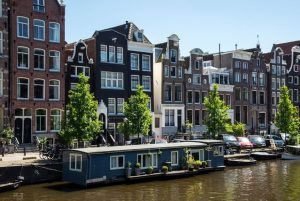Description
The Accessible Amsterdam website (in Dutch) provides information about the accessibility of buildings in the city. Featuring accessibility and user-friendliness reviews of all sorts of public buildings, it helps visitors to plan their trip. The site also has information on public transport accessibility.
Accessibility Information
Accessibility and mobility
Every citizen of Amsterdam must be able to participate in the city and surroundings. Young or old, with a disability or illness. That does not matter. Good accessibility to public space, buildings and public transport is therefore an important condition if you use crutches, a walker, wheelchair or mobility scooter. Or if you have a hearing aid, help or guide dog or walk with a stick. And also as easy as you walk behind a pram or carry a lot of luggage with you.United Nations Convention
The UN Convention on the rights of people with disabilities states:"All buildings and facilities must be accessible to people with disabilities, and adjustments must be made where necessary."
In daily practice this means, among other things, that:
Sidewalks should be wide enough and not be filled with billboards, bicycles or parked cars.
There must be benches in the street to be able to rest.
There are safe crossings with ramps and exits.
Signposts are clear.
Buildings are accessible.
There are accessible tram and bus stops that are not too far apart.Feel welcome
Not every restriction is visible. And not everyone can stand or walk for a long time. Many people have difficulty reading. Not everyone can find the way, is quick to understand, or can easily tell what he needs. That is why you should feel welcome when you come or use something. Employees and other visitors need to understand your disability.What we do about it
We point out to the municipality of Amsterdam and other organizations in the city the importance of accessibility. We insist that accessibility is part of the policy and plans. And we assess many plans for accessibility. Experiences of people from daily practice are indispensable here. That's why we work a lot with interest groups of people with disabilities in the city boroughs.Mobility
People with disabilities and older people want to be able to move well, independently and safely. With or without a tool or guidance. That is why Public Transport (OV) must be easily accessible and accessible. Even if you use target group transport, you must be able to rely on this being carried out properly. But not only that: more freedom of choice must come. One trip is fine with public transport, the other with the Supplemental Public Transport. Or a modified car, a Canta or a scooter. The way someone prefers to go from A to B should be central.What we do about it
We are committed to good public transport. What we pay a lot of attention to:Trams, buses and metros with a ground floor entry.
Good seats for people who have difficulty walking.
Travel information must be understandable; not only easy to read, but also good to hear.
Stops and transfer points must be easily accessible and not too far apart.
Customer friendliness in public transport.
The target group transport must be better connected to the ordinary public transport and to the wishes of users.Photos
Reviews


